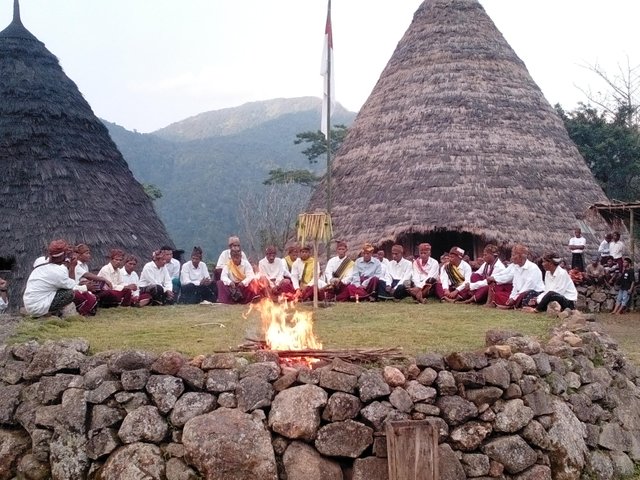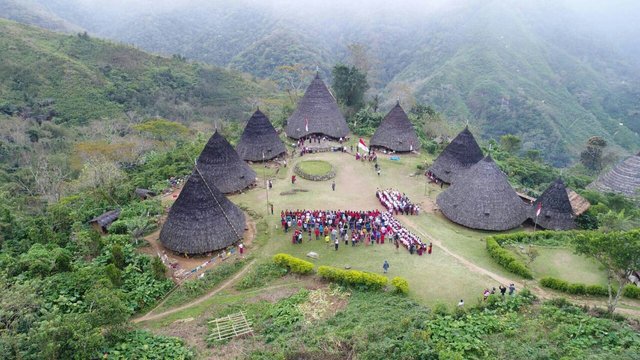Come and Feel the Sensation of Waerebo Village, Flores Indonesia
Hello Steemers, good day. How are you all?. Nice to see you again.
Today, I am going to post something which I think it is very useful. Alright. Let's begin.
Have you ever heard the word "WAE REBO?. Yeah, it is a village, very traditional village located in west Flores, pricesly in Manggarai regency. Here is the look of Wae Rebo I am talking about!
WAE REBO VILLAGE
Wae Rebo is an old Manggaraian village, situated in pleasant, isolated mountain scenery.
The village offers visitors a unique opportunity to see authentic Manggarai housing and to experience the everyday life of the local community.
In the village of Wae Rebo, visitors can see mbaru niang – traditional, circular cone-shaped houses with very unique architecture. Nowadays, it is still a place to hold meetings, rituals and Sunday-morning prayers together.
The village can only be reached by way of a three-hour hike (depending on your physical condition) from the lowlands. The hike is definitely worth the effort: the dense rain forest along the narrow path to Wae Rebo is one of a stunning biological diversity.
Not only does it host interesting vegetation, including orchids, palms, and different ferns, but also an impressive population of singing birds.
Wae Rebo has been supported to become the major culture tourism attraction in West Flores. Together with a team of Jakarta-based architects and the Indonesian government, the local community renovated four of their mbaru niang – or ‘drum houses’ in the Manggaraian language

The circular, cone-shaped buildings were all rebuilt in a traditional way. In contrast today’s rectangular buildings, the hearth is situated in the center of the house.
The massive roof, made out of palm fiber, is supported by a central wooden pole. The ceremonial house – differing in size from the other buildings – is the place where sacred heirloom drums and gongs are stored, and where different ceremonies and rituals are held.
This house is a communal building, gathering eight families who are descended from a common ancestor under its huge roof. Its structure symbolizes the unity of the clan, with the sacred drums considered the clan’s medium to communicate with the ancestors.
When you visit Wae Rebo, you will not only see the authentic Manggaraian housing, but also get an opportunity to experience the daily life of the local people.
Most of the people work in their gardens from early morning until dawn, busy with harvesting coffee and processing the beans. Even though weaving is not a major activity in Wae Rebo, you may encounter some women weaving traditional songket cloth.
Visitors are welcome to spend the night in the mbaru niang, and to socialize and dine with the Wae Rebo community. You will sleep on a tikar, a woven mat made out of pandanus leaf, in the mbaru niang, and get a taste of how life used to be when the extended families still lived their lives under one roof.
Facilities:
If you would like to stay in Wae Rebo for a night, there are several local guides as well as tour operators who can organize trekking and overnight stay for you
As the community offers you to experience their daily life, you will dine together with them and they will also take care of your well-being. Nevertheless, it is recommended to bring your own water supply with you.
How to get there
There are several options for getting to Wae Rebo:
Car or motorbike from Ruteng:
Start the 2.5 – 3 hour drive by heading south towards Golo Lusang. After having passed Pong Nggeok village, you will cross Wae Mese bridge. Go ahead to Narang village, followed by Nanga Ramut village, and you will end up in Dintor.
From this small fishing village you can see the beautiful Mules Island. The road to the north brings you to Kombo – Wae Rebo’s twin village – and finally to Denge village, which is the starting point for the hike to Wae Rebo.
Truck (oto kayu) from Ruteng:
From the Mena Bus Terminal, the truck route will take you across the villages of Cancar, Pela, Todo, and Dintor before you finally reach Denge Village.
The oto kayu usually departs from the terminal in the afternoon. The trip takes about 3 – 3 1/2 hours. If you want to go back from Denge to Ruteng, you will have to wake up early as the bis kayu departs from Denge at 5.30am.
Boat:
The boat trip is a good option if you start the trip from Labuan Bajo. Head south to the coastal village of Nangalili. Once there, you have to rent a boat (about Rp 400,000) to take you to Dintor. As there is no regular boat schedule.
The boat trip takes about two hours and leads you across to Mules Island. After having arrived in Dintor, continue your trip to Denge by ojek (about Rp 10,000) for about 20 minutes.
Hiking
In Denge, start the hike by taking the path between a local homestay and village SDK (elementary school). The hike will lead you across three rest spots.
The first one is at Wae Lomba River, which is less than an hour from Denge. After another hour of trekking, you will find the second one, Pocoroko.
This is an important place for villagers (and visitors) who want to make phone calls and send text messages from their mobile phones, as there is no mobile signal in Wae Rebo.
From Pocoroko you will reach the third post, Nampe Bakok, which takes about 40 minutes. From here, enjoy the beautiful hill scenery before you reach Wae Rebo.
***Whence is your visit. Im always waiting for you. Cause Iam looking forward for your visit!***
Love and tranguility form WaeRebo, Manggarai, Indonesia
****@rikardosambulawa***

You have completely captured my imagination. Indonesia has so much natural beauty. I find the difficulty to get to this village makes it even more appealing. Can you stay longer than one night?
yeah...just come. You may stay longer than one night, two nights or more. In fact, by stay longer, you'll really experience the sensation of living and observing the life of the folks...by the way, the locals are very accomodating and welcoming and very friendly. They love meeting new people.